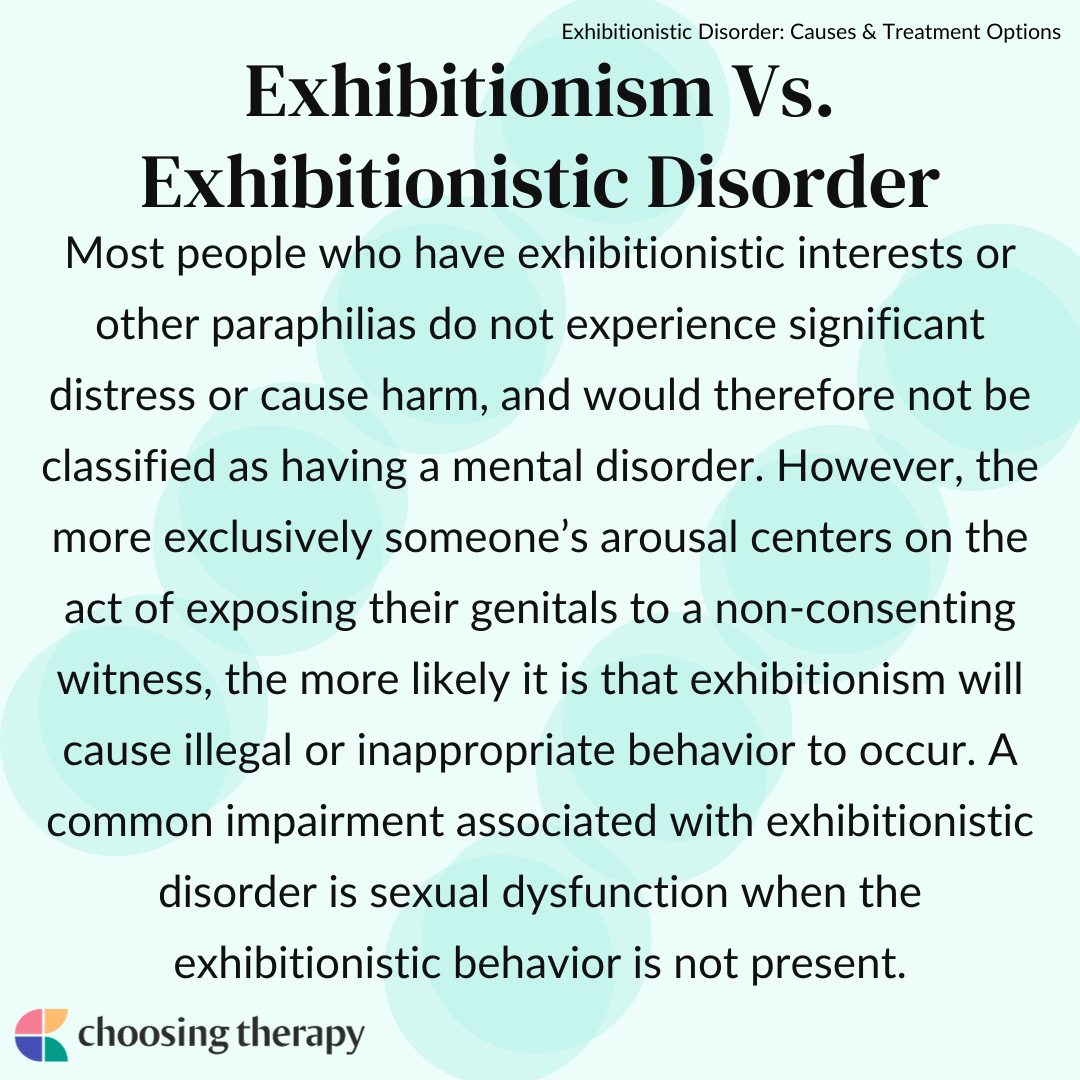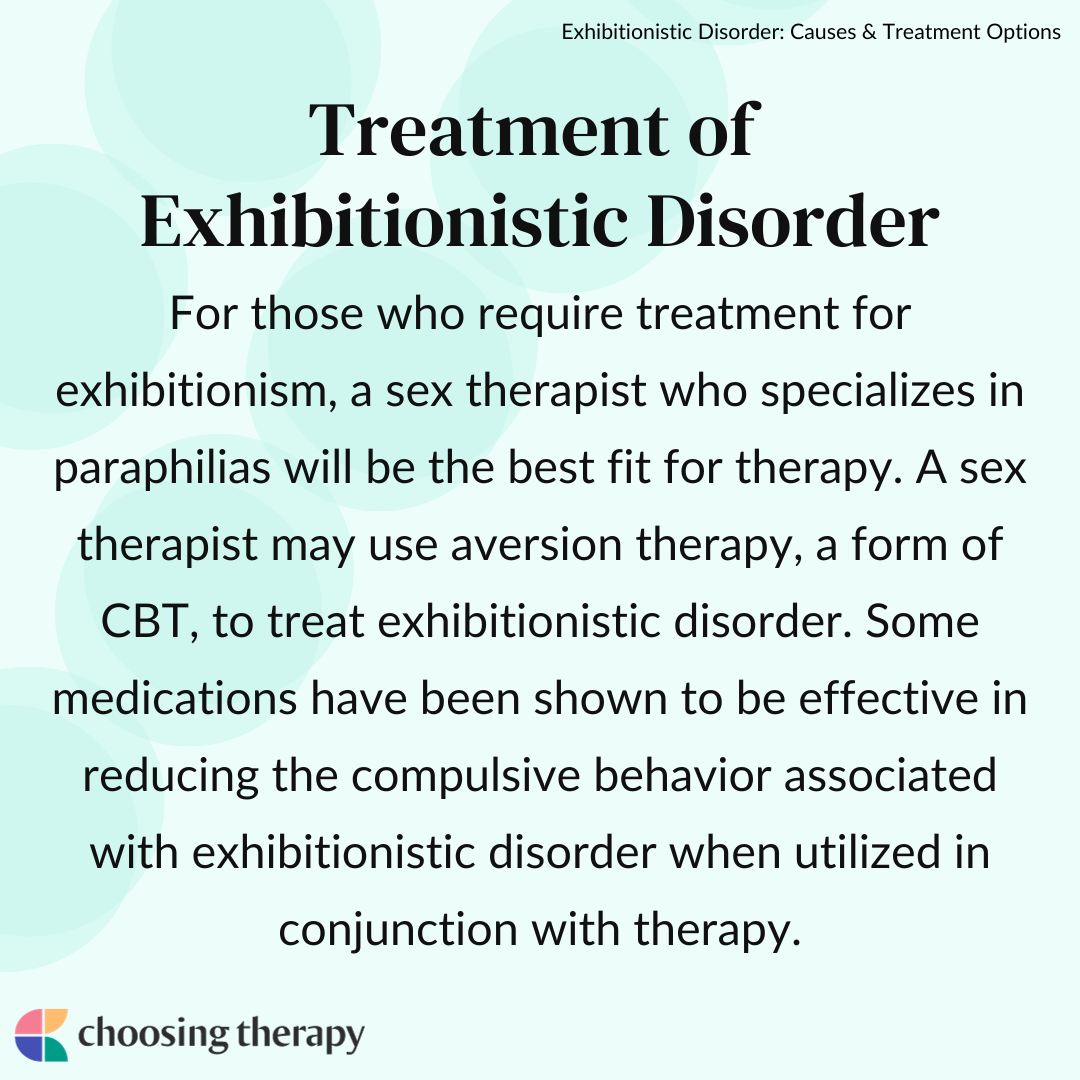Exhibitionistic disorder is characterized by sexual excitement through genital exposure, typically to a stranger. Often the exhibitionist has a need to surprise or shock the unwilling viewer. Sometimes, the person exposing themselves may be genitally aroused or masturbate during exhibitionistic behavior. In order to qualify as a mental disorder this behavior must cause harm to self or others.
Would you like to experience a better sex life? A therapist can help you overcome the emotional challenges around sex. BetterHelp has over 20,000 licensed therapists who provide convenient and affordable online therapy. BetterHelp starts at $65 per week. Take a Free Online Assessment and get matched with the right therapist for you.
What Is Exhibitionism?
Exhibitionism refers to exposing one’s genitals to become sexually aroused. There can also often be an intense urge or elaborate fantasies that coincide with being watched by other people during sexual activity. Some people with exhibitionism seek out this specific kind of activity in real life, whereas others play out this fantasy while watching porn, masturbating, or role-playing with a partner.
What Is Exhibitionistic Disorder?
Exhibitionistic disorder involves recurrent and intense sexual arousal from the exposure of one’s genitals to an unsuspecting person, usually a stranger. Genital arousal and/or masturbation in conjunction with exposure of one’s genitals may occur for some as well. Generally, there is no further attempt at sexual activity with the non-consenting witness following genital exposure. In approximately 10% of cases reported to the police, there is an escalation to hands-on sexual contact, and there are occasional incidents of sexual assault or rape.1
Exhibitionistic disorder is a subcategory of paraphilic disorders, which involve an intense and persistent sexual interest in atypical sexual targets or activities that causes significant distress, functional impairment, and/or harm to self or others.
Exhibitionism in Men Vs. Women
Exhibitionistic disorder is believed to occur primarily in males, although single sexually arousing exhibitionistic acts might occur up to half as often among women compared with men.2 More information is needed to determine whether exhibitionistic disorder occurs at a clinically significant level within the female population.
Is Exhibitionism a Crime?
Exhibitionism can cause people to engage in the act of indecent exposure (deliberately exposing a body part inappropriately or having sex in public), which is a crime. The specific penalties for this crime vary from state to state, but first convictions typically result in misdemeanors, whereas subsequent convictions can result in felonies, jail, and/or significant fines.3
Can Exhibitionism Be Practiced Consensually?
Exhibitionism is not inherently a disorder, and people can practice exhibitionism consensually. For example, consenting partners may choose to play out this fantasy together via role-play. They may choose to engage in sexual acts in front of other consulting adults or participate in forms of group sex acts. Some people also film or take photos of themselves to share with their partners.
Exhibitionism Vs. Exhibitionistic Disorder
Most people who have exhibitionistic interests or who are affected by paraphilias do not experience significant distress or cause harm, and would therefore not be classified as having a mental disorder. However, the more exclusively someone’s arousal centers on the act of exposing their genitals to a non-consenting witness, the more likely it is that exhibitionism will cause illegal or inappropriate behavior to occur. A common impairment associated with exhibitionistic disorder is sexual dysfunction when the exhibitionistic behavior is not present.
Exhibitionism Examples
Exhibitionism comes in many forms, but the overarching fantasy is to expose oneself to others without their consent. Sometimes there is also a strong desire to be watched during masturbation or sexual acts with partners. Classic exhibitionism often entails flashing others (often in a crowded place like a subway) or masturbating in a public location.
Common forms of exhibitionism include situations like:
- Streaking in public
- Exposing genitals to someone in public (i.e. on public transportation)
- Having sex or masturbating in public
- Engaging in sexual acts in front of other viewers
Is Sending Nudes a Form of Exhibitionism?
Sending nude pictures may be a type of exhibitionism, particularly if they are sent unsolicited. Doing so may be considered a type of sexual harassment and can certainly have legal consequences. In addition, each state has particular child pornography laws regarding any sexting or nude photo exchanges between minors. It’s always important to remember the inherent risk involved with sharing or receiving these kinds of photos.
Top Rated Online Therapy Services
BetterHelp – Best Overall
“BetterHelp is an online therapy platform that quickly connects you with a licensed counselor or therapist and earned 4 out of 5 stars.” Visit BetterHelp
Talkspace – Sex & Intimacy Counseling for Couples
Get closer to your partner with private and convenient counseling, from the comfort of your home. Visit Talkspace
Types of Exhibitionism
Like all paraphilias, exhibitionism exists on a spectrum, and many people can have this fantasy without acting on it. Likewise, people can also choose to safely play out this fantasy privately or with consensual partners without breaking the law. That said, exhibitionism can also be understood by its two dominant types: pure exhibitionists and exclusive exhibitionists.
- Pure exhibitionists: Pure exhibitionists show their genitals to strangers. However, they do not touch or seek to physically harm people.
- Exclusive exhibitionists: Exclusive exhibitionists primarily derive sexual pleasure from exhibitionist acts. As a result, they often have problems with typical forms of monogamy or in their sexual relationships.
Symptoms of Exhibitionistic Disorder
The main symptom of exhibitionistic disorder is a recurrent and intense sexual arousal from the exposure of one’s genitals to an unsuspecting person, as manifested by fantasies, urges, or behaviors. A person with exhibitionistic disorder is often only able to achieve arousal when inappropriate exposure of the genitals is present, and they may feel shame and distress at the atypical focus of their sexual desire.2
Symptoms of exhibitionistic disorder include:2
- Experiencing exhibitionistic fantasies, urges, or behaviors for at least six months
- Acting on these urges with a non-consenting person
- Sexual urges or fantasies cause clinically significant distress or impairment in social, occupational or other important areas of functioning
Exhibitionistic Disorder may be categorized as the individual becoming sexually excited by exposing genitals to:2
- Prepubertal children
- Physically mature adults
- Prepubertal children and physically mature adults
Sexually active adults may occasionally become aroused by exhibitionistic behavior, but in the absence of fixation and mental distress, this arousal would not be classified as a mental disorder.
Causes & Triggers of Exhibitionistic Disorder
Exhibitionistic disorder typically develops during adolescence. Antisocial history, alcohol or other substance misuse, and pedophilic sexual preference may increase the risk of developing exhibitionistic disorder, although causality has not been determined. These factors might also increase the risk of sexual recidivism in exhibitionistic offenders.
Although childhood abuse and hypersexuality have both been correlated with exhibitionistic disorder, there is no conclusive evidence regarding what causes or triggers exhibitionistic proclivities.
Impacts of Exhibitionistic Disorder on Individuals & Relationships
Exhibitionistic disorder commonly leads to sexual shame and emotional distress in people who experience this type of arousal. Internal conflict and fear of judgment can lead to isolation and difficulty finding or honestly communicating in sexual relationships. Partners of those with exhibitionistic disorder may feel inadequate, unattractive or worried about the implications of an exhibitionistic interest.
Sexual dysfunction can occur when no outlet for exhibitionistic urges is present. Erectile dysfunction (ED) or delayed ejaculation (DE) may lead individuals or couples to seek treatment for exhibitionistic disorder.
How Is Exhibitionistic Disorder Diagnosed?
Exhibitionistic disorder is most often diagnosed when someone is caught exposing their genitals, receiving a citation for lewd or inappropriate public behavior, and having been remanded to psychological treatment.
Treatment of Exhibitionistic Disorder
For those who require treatment for exhibitionism, a sex therapist who specializes in paraphilias will be the best fit for therapy. A sex therapist may use aversion therapy, a form of CBT, to treat exhibitionistic disorder. Some medications have been shown to be effective in reducing the compulsive behavior associated with exhibitionistic disorder when utilized in conjunction with therapy.
Sex Therapy
Counseling with a certified sex therapist who specializes in paraphilias will ensure a knowledgeable and non-judgmental approach to psychotherapy. A sex therapist will take a detailed sexual and psychosocial history to assess for factors that contribute to the exhibitionistic interest and its expression through urges, fantasies and behaviors.
The therapist will explore the onset and context of the symptoms being experienced, especially any changes in the situations or cues that have escalated exhibitionistic thoughts or urges. They will then likely offer coaching on mindfulness and behavioral techniques that either an individual or couple can explore. Co-occurring psychological conditions, such as mood disorders or hypersexuality, will also be assessed and treated.
Therapy is a safe place to explore your sexuality. BetterHelp has over 20,000 licensed therapists who provide convenient and affordable online therapy. BetterHelp starts at $65 per week. Take a Free Online Assessment and get matched with the right therapist for you.
Cognitive Behavioral Therapy (CBT)
Sex therapists with CBT training will employ cognitive restructuring techniques to identify and change thoughts and behaviors. They may utilize aversion therapy or guided imagery to reduce interest in exhibitionistic behavior. Studies have shown CBT to be an effective treatment for exhibitionistic disorder when utilized in conjunction with drug therapy.
Antidepressants
Selective serotonin reuptake inhibitors (SSRIs) can help with co-occurring mood disorders, such as depression or anxiety, while simultaneously lowering sex drive. A lowered sex drive can help with the impulsivity associated with exhibitionistic thoughts and behaviors, however does not directly address the exhibitionistic urge without therapy. In addition to the side effect of lowered sex drive, there is some evidence that suggests SSRIs can be helpful for impulsive behaviors of all types.
Antiandrogens
Medroxyprogesterone acetate and cyproterone acetate are members of a class of drugs which can be used to lower testosterone levels temporarily in order to reduce sex drive and allow for more effective therapy. These drugs help reduce the levels of circulating testosterone and prime the recipient for cognitive restructuring therapy techniques.
Group Therapy
Group therapy conducted in conjunction with individual therapy has been shown to be effective in reducing inappropriate behaviors and enhancing social skills.4
How to Get Help for Exhibitionistic Disorder
Most people who suffer from exhibitionistic disorder seek psychological treatment only when forced to do so by a court due to an inappropriate public exposure of their genitals. If you or your partner has an exhibitionistic interest which has had or may have negative consequences, seeking psychological help with a knowledgeable and nonjudgmental professional is an important step towards taking control of sexual impulses and channeling them into healthy and consensual behavior.
Finding an AASECT-Certified Sex Therapist
When consulting a therapist for the psychological treatment of sexual issues, make sure that your mental health practitioner is AASECT (American Association of Sexuality Educators Counselors and Therapists) certified. “Sex therapist” and “sex therapy” are not protected terms, meaning that anyone can call themselves a sex therapist in their marketing. Additionally, most mental health licensure requirements contain little or no instruction in human sexuality. AASECT certified providers receive an additional 18-24 months of training and a minimum of 300 additional hours of supervision in sex specific psychological issues.
How Much Does Sex Therapy Cost?
Typical rates for an AASECT certified sex therapist are on the upper end of private pay therapy rates in your area. Most sex therapists see individual clients for 45-60 minute sessions at rates between $120-$180 and couples for 75-90 minute sessions at rates between $190-$310. These rates may vary widely based on the availability of certified sex therapists in your area and on general mental health costs in your state.
Coping With Exhibitionistic Disorder
There are healthy ways to channel exhibitionistic urges. Exhibitionistic desires to be observed by other people during sexual activity can be channeled appropriately with like-minded individuals within the fetish or lifestyle communities. Exhibitionism in a consensual group context and/or with a like-minded partner can provide a healthy outlet for exhibitionistic urges.
If you are suffering from exhibitionistic disorder make sure to:
- Talk honestly with your partner(s) about your sexual urges and fantasies. Partners are more likely to be supportive and understanding when your behavior is not secretive or dishonest
- Consult with a certified sex therapist to explore your options for reducing compulsive behaviors and co-occurring mental health conditions
- Minimize the use of alcohol and other inhibition lowering substances which may increase the inappropriate acting out of exhibitionistic urges
- Seek a community of other individuals struggling with exhibitionistic disorder or who have been successful in channeling their urges, fantasies and behaviors into a consenting sexual forum
Remember that, like most mental health conditions, exhibitionistic disorder is more effectively treated the sooner it is addressed.
Would you like to experience a better sex life? A therapist can help you overcome the emotional challenges around sex. BetterHelp has over 20,000 licensed therapists who provide convenient and affordable online therapy. BetterHelp starts at $65 per week. Take a Free Online Assessment and get matched with the right therapist for you.
Exhibitionistic Disorder Vs. Other Disorders
While exhibitionistic disorder may be similar to other disorders, there are some key differences that are important to keep in mind. The significant distress, impairment, or harm caused by exhibitionistic disorder often sets it apart.
Exhibitionistic Disorder Vs. Exhibitionism
Exhibitionism is an outdated term utilized prior to the updated Diagnostic and Statistical Manual of Mental Disorders (DSM-5). Prior to the DSM-5, Exhibitionism was classified as an impulse control disorder, not a paraphilia. The crucial difference in this new terminology is that exhibitionistic disorder requires there be significant distress, impairment or harm accompanying the pattern of sexual behavior in order to be designated as a mental disorder.
Exhibitionistic Disorder Vs. Conduct Disorder & Antisocial Personality Disorder
Conduct disorder in adolescents and antisocial personality disorder in adults are characterized by norm-breaking behavior, which may include behavior that is included in exhibitionistic disorder. However, the sexual arousal experienced by exposing one’s genitals in the context of exhibitionistic disorder would be lacking in conduct disorder or antisocial personality disorder and additional norm-breaking behaviors would be present.
Exhibitionistic Disorder Vs. Substance Use Disorders
Alcohol and substance use disorders may involve single exhibitionistic episodes. However, recurrent sexual fantasies, urges, and behaviors related to exposing one’s genitals would be absent when the individual is not intoxicated.
Exhibitionistic Disorder Vs. Exhibitionists
People who self-identify as being aroused by being observed by strangers in sexual acts or engaging in public sex, but engage only in consenting behavior and do not report distress, impairment, or harm to self or others are not classified as having a mental disorder.
Exhibitionistic Disorder Statistics
Consider the following statistics about exhibitionistic disorder:
- Exhibitionistic disorder is estimated to occur in 2-4% of the male population.2
- Exhibitionistic disorder occurs almost exclusively in men. However, single sexually arousing exhibitionistic acts might occur up to half as often among women compared with men.2
- Exhibitionistic sexual preferences and behavior may decrease with age.2
- Approximately one-third of sex crimes reported to the police are related to incidences of exhibitionism.1
- Approximately 10% of exhibitionistic behavior escalates into hands-on sexual contact of victims.1
- 20-50% of men arrested for exhibitionism are rearrested within two years.1
- Childhood abuse, hypersexuality and pedophilic sexual preference have all been linked to exhibitionistic disorder, although a causal relationship has not been determined.2
- Exhibitionistic disorder typically develops during adolescence, however the behavior may be difficult to discern from normative and age appropriate sexual curiosity until later in life.2
Evolution of Exhibitionistic Disorder as a Mental Health Diagnosis
Exhibitionistic disorder has been included in the Diagnostic and Statistical Manual of Mental Disorders (DSM) under various iterations since its inception in 1952. Initially, exhibitionism was classified as a sexual deviation under psychopathic personality disorders, indicating that anyone with these urges was unlawful and/or psychotic.4
The forensic usage of this diagnosis to categorize the criminal behavior of sexual predators continues to have useful applications. However, the paraphilic diagnoses, including exhibitionistic disorder, have been criticized as an attempt to control deviant behavior and arguably do not meet the criteria for true mental health diagnoses. Paraphilic diagnoses have been used to pathologize, stigmatize, and discriminate against those who engage in alternative sexual practices. Sexual arousal stemming from the urge to be observed naked or engaged in sexual activity does not constitute pathological thinking.
Throughout subsequent editions of the Diagnostic and Statistical Manual of Mental Disorders (DSM) discernment was slowly made between consensual sexual practices which do not cause distress as compared to harmful urges, fantasies or behaviors which would constitute a psychological disorder requiring treatment. However, a lack of valid data or scientific consensus regarding the etiology of exhibitionistic disorder continues to make this diagnosis controversial.
Additional Resources
To help our readers take the next step in their mental health journey, Choosing Therapy has partnered with leaders in mental health and wellness. Choosing Therapy is compensated for marketing by the companies included below
Sex & Intimacy Counseling for Couples
Get closer to your partner with private and convenient counseling, from the comfort of your home. Visit Talkspace
Sexual Healthcare For Men
Get ED meds online shipped to you if prescribed. FDA-approved ED pills, with treatments starting at less than $2/day. 100% online, discreet delivery. No waiting weeks for an appointment. Visit Hims
Sexual Healthcare For Women
Plushcare – Get personalized, high-quality healthcare online. In-network with most major insurers, with a typical out-of-pocket cost of just $30. Painful Sex Treatment and HSDD (low sex drive in women)
Best Online Therapy Services There are a number of factors to consider when trying to determine which online therapy platform is going to be the best fit for you. It’s important to be mindful of what each platform costs, the services they provide you with, their providers’ training and level of expertise, and several other important criteria.
Best Online Psychiatry Services Online psychiatry, sometimes called telepsychiatry, platforms offer medication management by phone, video, or secure messaging for a variety of mental health conditions. In some cases, online psychiatry may be more affordable than seeing an in-person provider. Mental health treatment has expanded to include many online psychiatry and therapy services. With so many choices, it can feel overwhelming to find the one that is right for you.







